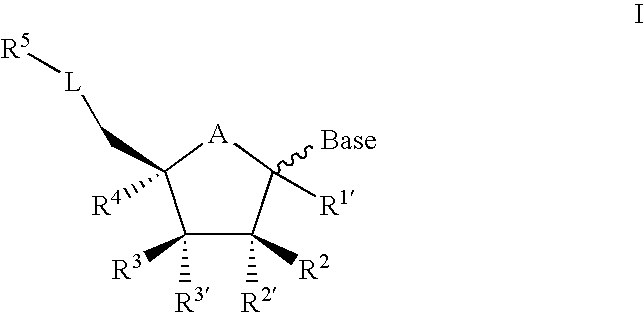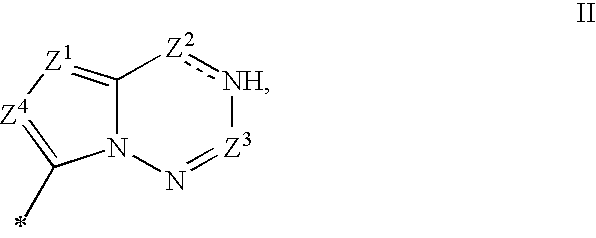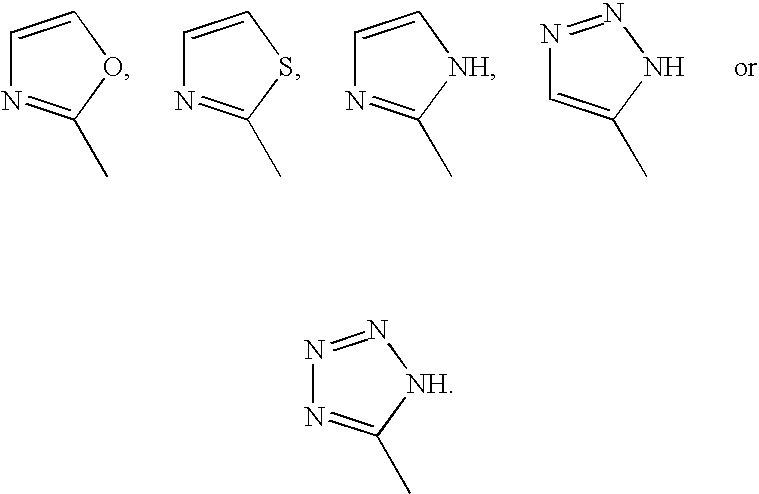Bicyclic nucleosides and nucleotides as therapeutic agents
a technology of bicyclic nucleosides and nucleotides, which is applied in the direction of saccharide compounds with non-saccharide radicals, saccharide compounds with heterocyclic radicals, and aminosugars, etc. it can solve the problems of only being effective in about half the patient population, surgery and radiation therapy is limited to certain, and the effect of inhibiting the activity of hcv ns5b
- Summary
- Abstract
- Description
- Claims
- Application Information
AI Technical Summary
Benefits of technology
Problems solved by technology
Method used
Image
Examples
example 1
Preparation of 4-amino-7-(2-C-methyl-β-D-ribofuranosyl)-pyrrolo[2,1-f][1,2,4]triazine (Compound 9)
[0313]
[0314]Step i: Compound 1,3,5-bis-O-(2,4-dichlorophenylmethyl)-1-O-methyl-2-C-methyl-D-ribofuranose (19.2 g) in anhydrous THF (200 mL) was chilled to 0° C. under Ar in an ice:water bath then treated with NaH (60% dispersion in oil, 2.6 g) in 4 batches at 10 min intervals. The suspension was warmed to RT then treated dropwise with 2,4-dichlorobenzyl chloride (11.2 mL). The reaction was then heated to 70° C. under Ar for 16-24 h. The cooled reaction mixture was filtered, and the filtrate was eluted on silica with 10-30% EtOAc:hexane to form Compound 2 as a mixture of α and β anomers (16.68 g): 1H NMR (CDCl3) major anomer: δ 1.42 (s, 3H); 3.46 (s, 3H); 3.64 (d, 1H, J=4.8 Hz); 3.73 (dd, 1H, J=3.9, 10.7 Hz); 3.67 (dd, 1H, J=4.4, 10.7 Hz); 4.29 (q, 1H, J=4.3 Hz); 4.56-4.85 (m, 7H); 7.11-7.25 (m, 3H, J=2.0, 8.4 Hz); 7.31-7.41 (m, 5H); 7.58 (d, 1H, J=8.4 Hz).
[0315]Step ii: Compound 2 (6.91...
example 2
Preparation of 4-amino-5-fluoro-7-(2-C-methyl-β-D-ribofuranosyl)-pyrrolo[2,1-f][1,2,4]triazine (Compound 11)
[0322]
[0323]Step i: to a suspension of Compound 8 (0.11 g) in acetonitrile (2 mL) was added Selectfluor™ (1-Chloromethyl-4-fluoro-1,4-diazoniabicyclo[2.2.2]octane bis(tetrafluoroborate) (80 mg), and the mixture was stirred and sonicated at RT for 5 min. The tube was sealed and heated in a microwave reactor at 82° C. for 15 min. The solvent was removed in vacuo to render a dark brown gum. The crude product (Compound 10) was suspended in 2 mL DCM and applied to a silica flash column and eluted with 12% EtOAc / hexane to afford the product as a pale brown foam (30 mg): 1H NMR (CDCl3): δ 7.79 (s, 1H), 7.61 (d, J 8.4 Hz, 1H), 7.45 (d, J 8.2 Hz, 1H), 7.45 (d, J 8.2 Hz, 1H), 7.41 (d, J 2.1 Hz, 1H), 7.37-7.34 (m, 3H), 7.27-7.17 (m, 3H), 6.60 (s, 1H), 5.85 (s, 1H), 4.87 (s, 2H), 4.72 (s, 2H), 4.69 (q, J 12.6 Hz, 2H), 4.36 (td, J 8.5 Hz, 2.9 Hz, 1H), 4.07 (d, J 8.5 Hz, 1H), 3.97 (dd, J 2....
example 3
Preparation of 4-amino-5-chloro-7-(2-C-methyl-β-D-ribofuranosyl)-pyrrolo[2,1-f][1,2,4]triazine (Compound 12)
[0325]
[0326]Step i: Compound 9 (52 mg) in anhydrous DMF (2 mL) under Ar was chilled to 0° C. and treated dropwise with a solution of N-chlorosuccinimide in anhydrous DMF (27 mg in 1 mL). The mixture was warmed to RT and stirred for 1 h. The mixture was concentrated then eluted through a silica column with 0-10% MeOH:EtOAc to give Compound 12 (5.3 mg): ESI-MS m / z 407.1 ([M+H]+); 1H NMR (d6-DMSO): δ 0.83 (s, 3H); 3.60 (m, 1H); 3.70-3.74 (m, 4H); 4.74 (s, 1H); 4.84 (t, 1H, J=5.0 Hz); 4.91 (d, 1H, J=6.4 Hz); 5.36 (s, 1H); 6.86 (s, 1H); 7.83 (s, 1H).
PUM
| Property | Measurement | Unit |
|---|---|---|
| intracellular half life | aaaaa | aaaaa |
| plasma half life | aaaaa | aaaaa |
| temperature | aaaaa | aaaaa |
Abstract
Description
Claims
Application Information
 Login to View More
Login to View More - R&D
- Intellectual Property
- Life Sciences
- Materials
- Tech Scout
- Unparalleled Data Quality
- Higher Quality Content
- 60% Fewer Hallucinations
Browse by: Latest US Patents, China's latest patents, Technical Efficacy Thesaurus, Application Domain, Technology Topic, Popular Technical Reports.
© 2025 PatSnap. All rights reserved.Legal|Privacy policy|Modern Slavery Act Transparency Statement|Sitemap|About US| Contact US: help@patsnap.com



